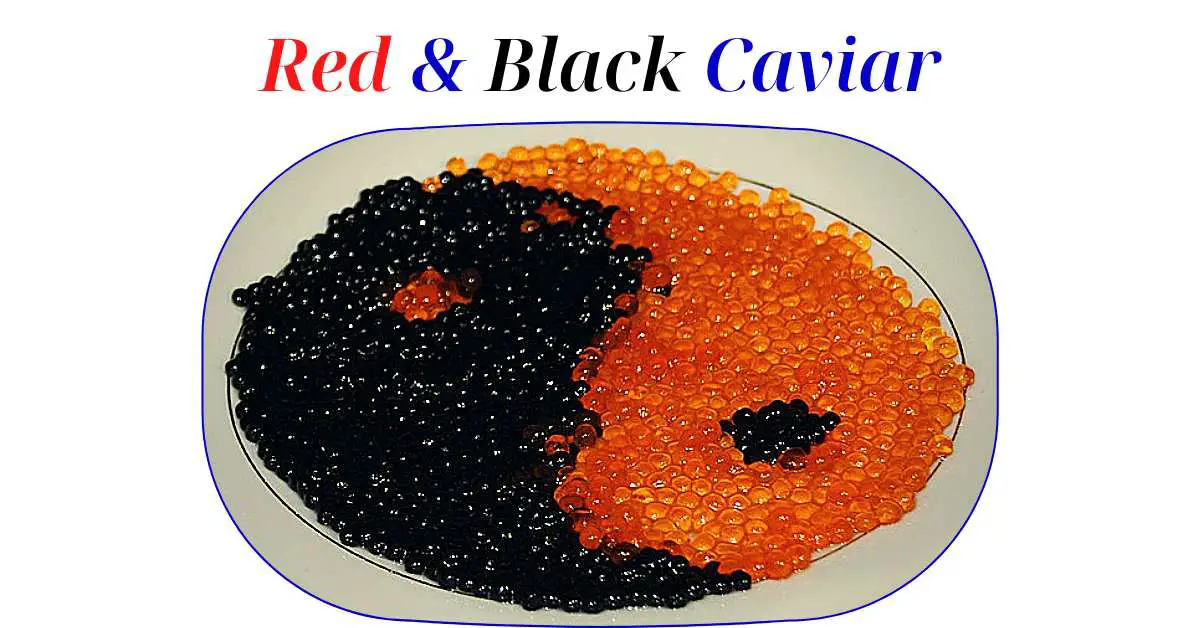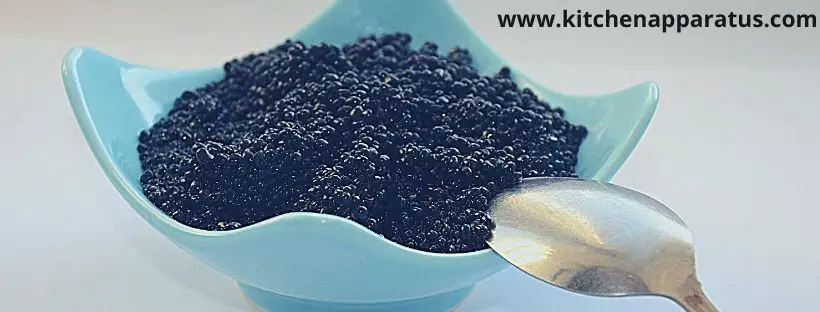
Caviar is a luxury food item.
A delicacy of the rich and famous, caviar is a food that can be enjoyed by everyone. But it doesn’t have to be an expensive one. There are many types of caviar available on the market today and choosing the right type for you can be tricky.
This post will help guide you through what types of caviar exist and how to choose which one is best for your taste buds and budget.

1. What is caviar, and what are the different types of caviar to choose from?
Caviar is the “eggs” of a type of sturgeon fish . Sturgeon fish are large, bottom-feeder type fish with scaly skin and bony plates that live in freshwater rivers.
Freshwater sturgeon include 25 species worldwide, shipped to the US from both lake sturgeon and paddlefish sturgeon. There are also numerous saltwater types of sturgeon fish , which are not shipped to the US due to an import ban on endangered marine species.
2. How much does caviar cost – where can you find the best prices on various kinds of caviar?
The cost of caviar varies greatly depending on the type of caviar you choose. Normally, sturgeon fish are farmed and harvested in large quantities – making it a fairly inexpensive luxury food.
But if you want top-of-the-line quality (i.e., wild, extremely fresh) from a small batch producer who harvests the fish in limited quantities, you will pay a lot more for that luxury.
One of the most popular types of caviar used is Osetra . It is a European sturgeon species from both the Caspian and Black seas.
However, because of overfishing in those regions during the early-2000s, it is now only available from farms located there. The best way to purchase fresh farm-raised Osetra Caviar is directly from your local caviar importer or distributor.
3. Why do freshness and quality matter to me when purchasing caviar? Where should I look for an indication of freshness?
The fresher the caviar, the better it tastes. As with most foods, including fruit and vegetables, caviar loses its flavor and texture as time passes.
Fresh caviar has a nice firm texture to it when you press on the eggs with your fingers or tongue; they don’t feel spongy at all (the opposite of overripe tomatoes or apples). Freshly harvested caviar should never have a fishy odor. It should only have the faint scent of salt water.

4. The difference between Osetra, Sevruga, Beluga, and White sturgeon caviars can be confusing to shoppers.
Unfortunately, there is no single “best” kind of caviar out there. It really depends on your personal taste, what you’re serving it with, and what occasion it’s for (i.e., gift or a dinner party).
Caviar can range in color from bright orange-yellow to deep reds and browns – but the texture may vary depending upon how fresh the fish was when harvested (the fresher they are, the firmer the eggs are).
For example, beluga caviar has a firm feel to it when you press on it using your tongue or fingers; like little beads that pop against your mouth. Because its flavor profile is also quite strong, beluga caviar is best served to seasoned connoisseurs who appreciate the taste.
On the other hand, Osetra and Sevruga caviars are much softer in texture when you press on them, and have a very “faint” flavor profile; almost “muted” by comparison. This makes them perfect for either beginners or more casual dining/serving occasions like a dinner party with family & friends where you don’t want strong flavors from strongly flavored foods dominating the experience.
And because of its mildness, osetra caviar can be eaten alone without any accompaniment at all – although it’s often enjoyed alongside buttery crackers or thinly sliced fresh baguette bread.
5. Where to buy quality caviar for a good price?
If you’re looking for the absolute best quality, fresh caviar possible, I highly recommend finding a local importer or distributor near your area. Not only can you often get the freshest caviar, but they’ll have some of the best prices for it too.
6. How long does caviar last? What is the shelf life of different types of caviar?
Unfortunately, once opened, all caviars will spoil if not eaten promptly. There are certain ways to store them to extend their freshness, but they shouldn’t be opened for more than a day or so.

The best way to extend the shelf life of caviars once it has been opened is to keep them in an airtight container with fresh ice packs at all times; then placed on a flat surface away from direct sunlight (they should also not be stored at too high of temperatures – like near your oven or refrigerator’s heat source).
As far as the different types are concerned, Beluga can last up to 2 weeks once opened; Sevruga and Osetra last about 3 days.
7. What are some good accompaniments that pair well with caviar?
Caviar is classically served alongside thinly-sliced, buttered baguette bread or crackers, with a glass of chilled vodka on the side. However, there are numerous other accompaniments that pair well with caviar if you’re looking for something to complement it rather than mask its taste and texture (which is typically what people do when serving baguette bread or crackers).
One great option is lightly-tossed salads of crisp vegetables like cucumber, parsnip, celery root, etc. You can even make your own caviar vinaigrette , which adds both another layer of flavor and visual appeal!
Caviar can also be served alongside rich shellfish dishes (like crab cakes) as well as fruit courses – because these foods have a similar density to the caviar itself and can provide a satisfying contrast. And while you wouldn’t think it, egg-based dishes like quiches or even hard boiled eggs work great as well!
8. What do some of the different types of caviar taste like? Can they be used interchangeably in recipes?
The flavor profile will differ widely depending on the type of sturgeon fish that was harvested for its roe – whether it’s Beluga (which has a very strong flavor), Osetra/Sevruga (very creamy & mild), or Sturgeon Roe (more earthy & nutty).
While these roes are used to make many different kinds of caviars, they cannot be interchanged. However, when making your own items like homemade caviar, fish cake patties, or even your own quiches – you can choose the type of caviar that best matches your recipe.
9. Why is it important not to mix different types of caviars together in one dish?
Doing so may result in one of three possible outcomes: the two types of caviar might be compatible, they might look unappetizing, or they’re complimentary that could end up tasting delicious.

However, you don’t ever want to mix caviars that have been made from more than one type of sturgeon fish together because their flavors will be too much for your palate to handle. Likewise, never mix several varieties of caviar from multiple countries either .
The flavor profiles are just plain too different, which means instead of making a dish taste good – you’ll just be creating an unpleasant gastronomic experience for yourself and those who eat your food.
One last thing to remember: caviars from different seasons will not taste the same. Caviar is classified by its season much like other seafood – so some caviars will be mild while others are very briny; some have a nutty flavor profile, while others are buttery. This is why you’ll only see true experts mixing caviars from the same season together.
10. What’s the best way to tell if caviar has gone bad? Is it safe to eat once opened or should I toss it out?
There are a few ways you can tell if caviar has spoiled, which include:
- The smell – If the caviar smells bitter and/or funky, there’s a good chance that it’s already spoiled.
- The color – Some caviars change color when they’re too old; others will have black spots on them.
- Physical appearance – Caviar that hasn’t been refrigerated properly will clump up either outside of its tin container or be discolored within it (usually black or gray).
- Taste – When caviars start to go bad, they begin to taste bitter (so it’s better not to take the chance if you have any doubts about the freshness of your caviar).
However, as long as you purchased your caviar from a reputable dealer and it’s been stored properly in the refrigerator with a tight lid every time after opening , then yes, once opened there is nothing preventing you from enjoying all of the remaining caviar over time.
Conclusion Paragraph:
When it comes to caviar, the best way to find one that is perfect for you and your budget may be by experimenting with different types. Caviar can vary in flavor profile and price point depending on its country of origin, so don’t be afraid to try a few out before settling on the one that’s right for you.
We hope this post has been helpful!
If you have any further questions about what type of caviar would taste great or which variety might suit your needs best, please contact us and we’ll do our very best to help answer them!
